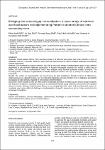Bridging the second gap in translation: a case study of barriers and facilitators to implementing Patient-initiated Clinics into secondary care
Date
2017-05-23Author
Subject
Metadata
Show full item recordAbstract
Rationale: Patient-initiated Clinics (PIC) have been found to be safe and have patient and service benefits in terms of satisfaction and cost. This paper reports our experiences of implementing PIC and the practical challenges of translating research into practice.Methods: The Knowledge to Action framework was used to inform the design of implementation plans in three different departments in one secondary healthcare organisation. A focused ethnographic approach was utilised to collect data on barriers and facilitators to implementation which were analysed using iterative qualitative analytic techniques. The Promoting Action on Research Implementation in Health Services framework was used to develop the analysis and data presentation. Results: The success of implementation was mixed across the three departments. Despite evidence of effectiveness, contextual issues at a department level, such as empowered leadership and team members, trust in colleagues and patients and capacity to make changes, impacted on the progress of implementation. Discussion: Patient-initiated Clinics can offer a useful and feasible alternative for follow-up care of some groups of patients with long-term conditions in secondary care and can be implemented through strong leadership and teamwork and a positive attitude to change. Although Implementation Science as an emerging field offers useful tools and theoretical support, its complexity may create additional challenges to implementation of specific interventions and so further contribute to the second gap in translation.
Collections
Publisher
Journal
Volume
Issue
Pagination
Publisher URL
Recommended, similar items
The following license files are associated with this item:


